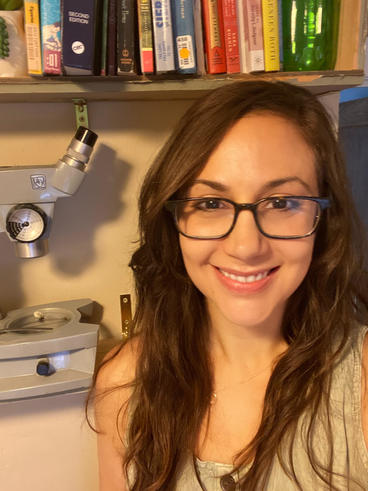Danielle is an evolutionary biologist interested in the process of adaptive evolution in the context of coevolving and convergently evolving systems. Danielle uses diverse methods to study these phenomena, including evolutionary biochemistry, biophysics, and comparative genomics. Currently, Danielle is a NIH TREM Postdoctoral Fellow at the University of Minnesota department of Ecology, Evolution, and Behavior (Lab of Dr Suzanne McGaugh).
Ph.D. Ecology, Evolution and Behavior, University of Minnesota, 2019
M.Sc. Environmental Biology, Tulane University, 2010
B.S. Environmental Biology and Anthropology, Tulane University, 2008
Research Statement
My research revolves around understanding two basic and intertwined phenomena in evolutionary biology: coevolution and convergent evolution. Though the study of coevolutionary relationships has been a focal point of evolutionary biology, demonstrating a truly reciprocally evolving interaction at the molecular and functional level in an empirical system has remained elusive. Coevolutionary interactions often span speciation events, or are present in repeated paired associations across disparate species, and thus represent ideal system in which to examine repeated evolution. My work leverages these qualities to examine the genetic, historical, and biophysical basis of extraordinary repeated and coevolutionary adaptations.
Publications
1. Drabeck, D.H., Rucavado, A., Hingst-Zaher, E., Cruz, Y.P., Dean, A.M., and S.A. Jansa. (2020) Resistance of South American opossums to vWF-binding venom C-type lectins. Toxicon 178: 92-99
2. Drabeck, D.H., Rucavado, A., Hingst-Zaher, E., Dean, A.M., and S.A. Jansa. Evidence for coevolution and cryptic convergence between opossums and. In Prep MBE
3. Drabeck, D.H. Resistance of Native Species to Reptile Venoms. In Handbook of Venoms and Toxins of Reptiles, ed. S. P. Mackessy. Boca Raton, FL: CRC Press. In Print 2021
4. Holding M.L.†, Drabeck D.H.† , Jansa S.A, Gibbs, H.L Venom resistance as a model for understanding the molecular basis of complex coevolutionary adaptations. (2016) Inregr. Comp. Biol. Online Advanced Copy July 21, 2016†- Joint lead authors- Both authors contributed equally to this publication
5. Drabeck, D., and Jansa, S. Why the honey badger don't care: Convergent evolution of venom-targeted nicotinic acetylcholine receptors in mammals that survive venomous snake bites. (2015) Toxicon 99: 68-72
6. Drabeck, D., Chattfield, M., Omalley, B., Richard-Zawacki, C. 2014. The status of Louisiana's diamondback terrapin (Malaclemys terrapin) populations in the wake of the Deepwater Horizon oil spill: Insights from population genetic and contaminant analyses. Journal of Herpetology 48:125-136.
7. Hekkala, E., Saumure, R., Jeager, J., Werner, H., Sredl, M., Culver, M., Bradford, D., Drabeck, D., Blum, M.J. 2011. Resurrecting an extinct species: Archival DNA, taxonomy, and conservation of the Vegas Valley leopard frog. Conservation Genetics 12: 1379-1385.
Publications: https://scholar.google.com/citations?user=MI6BqgYAAAAJ&hl=en
Website: http://www.danielledrabeck.com/
Teaching and Mentoring
My goals as an instructor are ultimately to inspire students to cultivate and nurture their curiosities, provide them with the skills to pursue those curiosities, and most importantly to instill in them a confidence that they are capable of making valuable contributions to science. I use evidence- based methods to incorporate active learning techniques to engage students in this daunting process with the support of their peers. Using these techniques allows my students to come away with a confidence and ownership of their ability to read and understand primary literature, formulate research questions, design independent research, and build peer learning groups.
Diversity and Inclusion Statement
As a woman, a mother, and a person with a disability I have become acutely aware of the systems in place within academic science that reduce diversity. Although the axes of inequity I have faced have been significant, they have opened my eyes to the privileges that have also served me, and thus my responsibility in dismantling the systems and policies that favor such privilege. As such, broadening the diversity of STEM is an important goal which has shaped my approach to teaching and mentoring.
I believe it is the responsibility of the educator (myself) to be up-to-date on the most recent and reliable pedagogy science and apply best practice in the classroom. In practice this means shaping my syllabi to include a variety of assessments (not simply high-stakes exams which have been shown to be biased against women and minorities), to include guidelines on respectful classroom behavior, and to provide accommodation and a welcoming atmosphere to people with disabilities, members of underrepresented groups, and students who have significant care roles (of parents, children, or siblings). In my classroom this is fostered by modeling productive and respectful discussion, exposing micro-aggressions, and having clear expectations of student behavior. This also includes an intentional effort to demystify academic research by providing ample opportunities for undergraduate research solicited to the class, as well as sharing personal stories and experiences of fieldwork/undergraduate research that may inspire students to participate in a career they may not have previously considered accessible to them.
